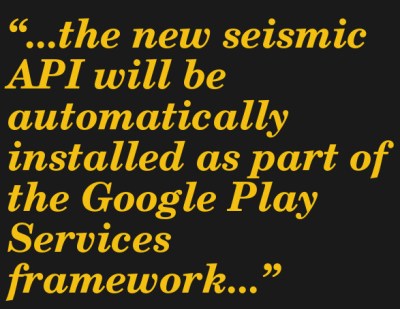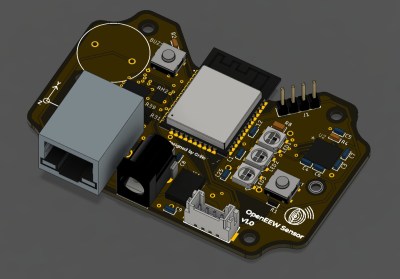Most people’s personal experience with seismographs begins and ends with simple childhood science experiments. Watching a pendulum make erratic marks on a piece of paper while your classmates banged on the table gave you an idea on how the device worked, and there’s an excellent chance that’s the last time you gave the concept much thought. Even among hackers, whose gear in general tends to be more technologically equipped than the norm, you’re unlikely to find a dedicated seismograph up and running.
But that’s not because the core technology is hard to come by or particularly expensive. In fact, one could say with almost absolute certainty that if you aren’t actively reading these words on a device with a sensitive accelerometer onboard, you have one (or perhaps several) within arm’s reach. Modern smartphones, tablets, and even some laptops, now pack in sensors that could easily be pushed into service as broad strokes seismometers; they just need the software to collect and analyze the data.
Or at least, they did. By the time you read this article, Google will have already started rolling out an update to Android devices which will allow them to use their onboard sensors to detect possible earthquakes. With literally billions of compatible devices in operation all over the planet, this will easily become the largest distributed sensor network of its type ever put into operation. But that doesn’t mean you’re going to be getting a notification on your phone to duck and cover anytime soon.
A Fair Weather Sensor
The accelerometers in our mobile devices were obviously never meant to detect earthquakes, but as any hacker knows, intent is often irrelevant when talking about hardware. The idea was for these sensors to determine the orientation of the gadget, or perhaps perform gesture detection, but they’re certainly capable of detecting subtle vibrations as well. Unfortunately, the use of this sensor for detecting earthquakes is hindered by an outside influence: the device’s owner.
Just imagine how often a smartphone is moved or shaken around on a daily basis. Or consider how the average user would react if their battery life was suddenly being reduced because Google was having their device constantly push accelerometer data upstream.

For these reasons, among others, smartphones in active use are no good as seismic sensors. So Google will only poll the sensors in devices which are plugged in and not being used. In many cases, that means the phones won’t be providing any useful data until their owner has gone to sleep.
Even then, there’s always going to be a question of where the phone has been placed. A proper seismometer should be securely anchored to the ground, but you can’t expect smartphone owners to place their devices on the basement floor every night. The phone could end up laying in bed with them, or placed on a table with a fan that vibrates all night.
So even when the phone isn’t being used, the data from these devices will need to be stringently analyzed, filtered, and cross-referenced with other sensors in the area. One shaking phone does not an earthquake make; it will take a complex algorithm to divine any meaning from the tea leaves that are millions of accelerometers chirping away at night.
Resistance is Futile
Obviously, the biggest hurdle in setting up a system like this would be getting everyone to install and configure the application on their phone. It’s the same reason that voluntary COVID-19 contact tracing applications have only been of limited use. If you can’t get more than a small percentage of the population to install an application that can tell them when they might have been exposed to coronavirus, good luck getting them to install one that sniffs out earthquakes.
 Which is why Google isn’t bothering to give them a choice. Not directly, at least. On devices running Android 5.0 or above, the new seismic API will be automatically installed as part of the Google Play Services framework rather than as a system update. That means even phones that have hit their End of Life (EOL) date will still pick up the new capability. You might not be getting security updates from your device manufacturer anymore, but you’ll be getting this.
Which is why Google isn’t bothering to give them a choice. Not directly, at least. On devices running Android 5.0 or above, the new seismic API will be automatically installed as part of the Google Play Services framework rather than as a system update. That means even phones that have hit their End of Life (EOL) date will still pick up the new capability. You might not be getting security updates from your device manufacturer anymore, but you’ll be getting this.
In the hierarchy of invasive snooping a company can do on your mobile device, collecting anonymous seismic readings while it’s charging seems pretty low. Google has indicated that there will be some mechanism for the phones to trigger on a seismic event rather than pointing a firehose of accelerometer data back at the server whenever a charging phone is idle:
If the phone detects something that it thinks may be an earthquake, it sends a signal to our earthquake detection server, along with a coarse location of where the shaking occurred.
It is, however, unclear if there will be a way to opt-out of this program other than disabling Location Services entirely. There’s no apparent incentive for Google, and whatever agencies they ultimately share the system with, to pull anything more than the accelerometer data and generalized location for these events. However, if that data becomes compromised, it’s impossible to say what else it might be useful for.
Being part of a massive network of sensors for scientific research is a really cool idea, aside from the privacy issue. It’s fair to say that if you own an Internet connected smartphone, there were far more serious invasions of your privacy happening already.
Who’s Data Is It, Anyway?
While our devices might be producing the data, it doesn’t seem that there’s any immediate plans for us to have access to it. Eventually we might see a public API that would allow developers to utilize the Android seismometer network, but for now, Google says the data will simply be integrated into Search. The idea is that if a user feels the ground shaking and turns to Google for more information, they’ll be able to see how large of an area has been impacted. After they’ve had time to refine the system the plan is to start pushing out earthquake warning notifications, something they’ve already experimented with as part of the United States Geological Survey ShakeAlert system.
For those who’d rather not wait on their friendly neighborhood megacorp to provide the public with this potentially life saving data, there are options. On the same day Google started rolling out their system, the Linux Foundation announced it would help support the OpenEEW Project.

This system gets its seismic data from open hardware sensors that combine an ESP32 with the same type of MEMS accelerometer found in smartphones, which you can either build yourself or (eventually) purchase as a turn-key product. While the project can never hope to compete with Google in terms of the number of active sensors in the field, these devices have the advantage of being permanently mounted and operating 24/7.
Whether its in your smartphone or an IoT device you build yourself, networks of these low-cost accelerometers seem poised to change the way earthquakes are detected. When even a few seconds advanced warning can be the difference between life and death, we’ll take all the help we can get.















I would love to put my phone in the paint shaker machine at the hardware store and see what kinds of alerts the server would get! Oh wait that’s evil not good.
The only thing that would accomplish is breaking your phone’s MEMS devices. You missed the part where it said it checks multiple devices to prevent false positives.
But if many phones are in the shaker it might work like the fake traffic jam…
https://www.youtube.com/embed/k5eL_al_m7Q?wmode=opaque&feature=oembed
Exactly! that would be the sort of daft prank that makes very little difference to anybodies life while pointing out how daft it is to trust in the google for all things.
Could it pick up a ‘Horizontal Mombo’ going on?
I had an older phone with a step counter that racked up to 12,000 steps after, an, er, session.
It would be a great experimental punking, ShakeitUP.
Do it!
Here’s a thought, why not use seismometers to act as seismometers. They are already in place and can do a better job.
.but seismometre can’t steal your password by key stroke or provide two way feedback for advanced advertisement techniques – like high frequency sound wave before.
why do i feel like i am living in “idiocracy” on a daily basis?/
Agreed, but like a camera with more pixels versus one with less, more relatively less accurate sensors spread over the same area could provide a higher res data set as to the actual event. Most seismometers are spread way too far to do much more than detection, strength recording, and through analysis of multiple seismometers, pin down a location.
With the charging phone method, you could potentially map the data and make a 2d “image” of the actual event.
If there’s no “opt out”, I’m expecting to see a spate of “earthquake emulator” hacks intended to flood the data with so much noise that Google just turns off the service…
Raspi based wireless charging station that randomly shakes your phone – and everybody else that has one at the same time since it’s triggered from some server. That would stop it.
This++
Doubt that would have any effect unless a larger amount of people start using them and these devices synchronize their attempts to create bullshit data. Otherwise they can just judge based on the majority of devices that aren’t providing such data.
Yes…I’m sure they thought of this and will filter out as part of noise filtering.
Also, they could just join the “shake pool” as a fake user and simply know exactly when a fake shake event is happening. Something like this has to be done within a trusted group if it’s going to be public. Also, if 100 phones shake in an area at exactly the same time, and the next 100 interspersed in the same are doesn’t, they will know something is up. Everyone in a given area would have to work together, which just won’t happen.
So, Google found a “good” app to justify installing enhanced spyware on all (most) Android devices.
Well played, Google, well played.
There ARE no “good” Google apps
They already HAVE Google Play Services spyware installed, this is just another bunch of data they’re grabbing.
For useful data, they would also need to track the location of the phone.
5G New Radio Positioning and Location-Awareness (10cm to 15m) or
GPS (1 to 10 meter resolution – public) or
Bluetooth (2 to 3m)
WiFi (3 to 25m)
LTE Cell (30m to 3km)
I for one can see no way that Alphabet Inc. could ever abuse tracking the location of phones. /end sarcasm tag
There has been for many years an app called “MyShake” that does this and reports the data to some seismologists. App comes from Univ Cal Berkeley.
Using the sensor in hard drives.
Why not just put one on every cell site. I’m sure that should give plenty of coverage. The FCC could make it part of the carriers license agrement. Sounds like GOOGLE just wants a crack in the door :-(
I thought your idea was good, but then I thought about the cell tower shaking in the wind.
Wind and seismic vibrations easy to filter
So, we’re going to filter out seismic vibrations from a theoretical device installed to detect seismic vibrations?
B^)
Lol…. Mount the seismometers at the base of the tower a couple of meters away…. Why would you assume they would be at the top?
My next phone will be 100% FOSS and run Linux, even if it costs me a lot more to buy it and it has less features, because I am as fed up now with Google’s disrespectful antics as I was with Microsoft +20 years ago. That also means that my entire family will be doing the same.
Which phone is that? Android is open-source and runs on top of Linux.
You mean no Android and just Linux? Not even the rPi has a full open-source stack.
Most mobile chipsets have both proprietary firmware and more proprietary libraries to talk to them.
I cannot find a decent, modern, portable tablet that can run Linux, let alone a phone.
Any phone that supports LineageOS – gapps is optional.
https://www.pine64.org/pinephone/
pinephone
Time to bring out another Shake-The-Baby game perhaps?
If this were an opt-in project, I’d be all for it. But the way it sounds they are rolling it out, it’s just another sign of the arrogance of Google.
– Yep, they are getting pretty ridiculous.
Is this going to be just the US, or worldwide? I live in Sweden and we very rarely experience any quakes that us strong enough to be felt. Hence no need what so ever for skynet to collect that data.
Also, I would like to know exactly what google play services does more…
That pinephone is looking more and more attractive for each day.